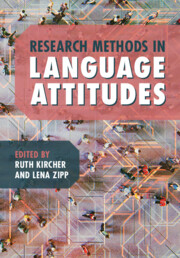Book contents
- Research Methods in Language Attitudes
- Research Methods in Language Attitudes
- Copyright page
- Contents
- Figures
- Tables
- Contributors
- Foreword
- Acknowledgements
- 1 An Introduction to Language Attitudes Research
- Part 1 Analysis of the Societal Treatment of Language
- Part 2 Direct Methods of Attitude Elicitation
- Part 3 Indirect Methods of Attitude Elicitation
- 12 The Matched-Guise Technique
- 13 The Verbal-Guise Technique
- 14 The Theatre-Audience Method
- 15 Experimental Methods to Elicit Language Attitudes among Children
- 16 The Implicit Association Test Paradigm
- Part 4 Overarching Issues in Language Attitudes Research
- References
- Index
- References
13 - The Verbal-Guise Technique
from Part 3 - Indirect Methods of Attitude Elicitation
Published online by Cambridge University Press: 25 June 2022
- Research Methods in Language Attitudes
- Research Methods in Language Attitudes
- Copyright page
- Contents
- Figures
- Tables
- Contributors
- Foreword
- Acknowledgements
- 1 An Introduction to Language Attitudes Research
- Part 1 Analysis of the Societal Treatment of Language
- Part 2 Direct Methods of Attitude Elicitation
- Part 3 Indirect Methods of Attitude Elicitation
- 12 The Matched-Guise Technique
- 13 The Verbal-Guise Technique
- 14 The Theatre-Audience Method
- 15 Experimental Methods to Elicit Language Attitudes among Children
- 16 The Implicit Association Test Paradigm
- Part 4 Overarching Issues in Language Attitudes Research
- References
- Index
- References
Summary
This chapter provides a comprehensive overview of the verbal-guise technique (henceforth VGT), a variant of the speaker evaluation paradigm in which guises representing different language varieties are produced by different speakers, each speaking in their habitual language variety. First, key features of the VGT are discussed. Second, a brief historical sketch of the technique’s introduction, development, and proliferation in language attitudes research is offered. Third, key advantages (e.g. speaker authenticity, ease of implementation) and disadvantages (e.g. lack of full experimental control) of the technique are reviewed. Fourth, various practical considerations surrounding research planning and design are described and several recommendations are offered, including: (a) matching speakers on various demographic factors (e.g. sex, age), (b) matching speakers on extraneous vocal characteristics not of interest in the study (e.g. pitch), and (c) using multiple speakers to represent each variety of interest. Fifth, the main concerns surrounding the analysis and interpretation of data obtained using the VGT are discussed. Finally, a brief sketch is provided of the methodological considerations that were involved in designing a recent study utilising the VGT, which examined Americans’ attitudes toward standard American English and nine foreign accents: Arabic, Farsi, French, German, Hindi, Hispanic, Mandarin, Russian, and Vietnamese.
Keywords
- Type
- Chapter
- Information
- Research Methods in Language Attitudes , pp. 203 - 218Publisher: Cambridge University PressPrint publication year: 2022
References
Suggested further readings
- 4
- Cited by

